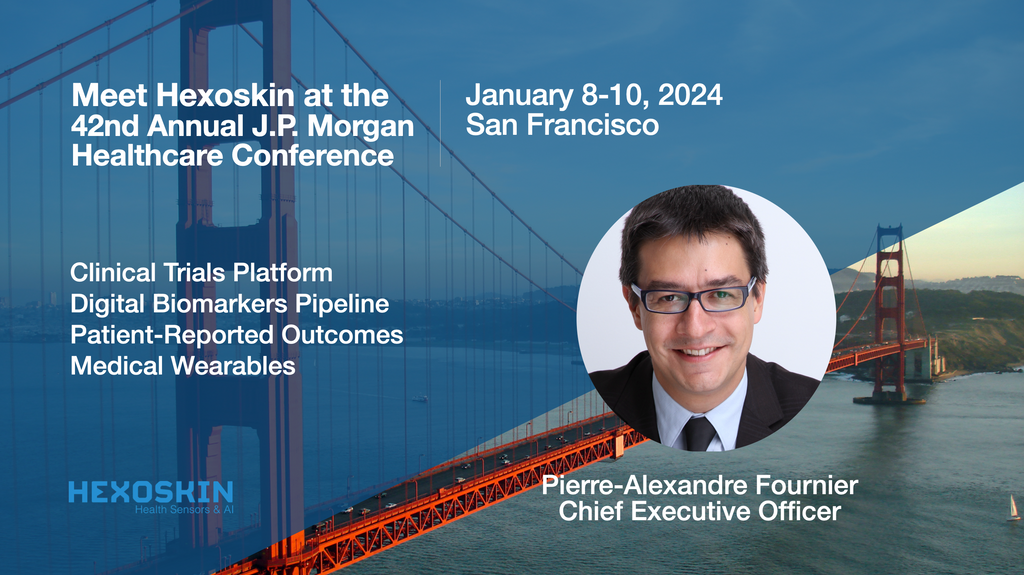- Continue Shopping
- Your Cart is Empty
Hexoskin @ HLTH 2025
Hexoskin will be presenting its latest products and clinical advancements at HLTH USA 2025 next week in Las Vegas.
We'll take the opportunity to meet with our clients and partners who use the Hexoskin software platform and wearables to advance our knowledge of human physiology.
We'll also present our new Hexoskin OneView platform for research and our digital biomarker pipeline in cardiology, respiratory diseases, nervous system disorders, and rare diseases.
Contact us to book a meeting: contact@hexoskin.com
HITLAB September 2024 Symposium on September 26
Hexoskin's CEO Pierre-Alexandre Fournier will be speaking at the HITLAB Digital Health Symposium on Digital Health this September 26th. The event will be streamed online and is free to attend.
Along with speakers from Genentech, Pfizer, Merck, Samsung, and many other innovative companies in health technologies and life sciences, Fournier will discuss the current state of digital biomarkers, wearables, and articificial intelligence in medicine.
For more than 20 years, HITLAB (Healthcare Innovation & Technology Lab) has been at the forefront of digital health research. The Columbia University-based organization partners with innovative healthcare technologies and life sciences companies to improve global health delivery and healthcare worldwide. HITLAB uses rigorous research and evidence-based methods to identify the best digital health solutions for their partners.
HITLAB Virtual Session: the Impact of Wearable Technology on Digital Diagnostics
Today we attended the 6th session of HITLAB's BT1 Virtual Knowledge Convene to discuss "The Impact of Wearable Technology on Digital Diagnostics". This was an opportunity to talk and discuss about the past, present, and future of medical wearables with Columbia University's HITLAB international community.
A few of the topics we covered:
• How wearables are revolutionizing healthcare data collection
• The potential of wearables for early disease detection and remote patient monitoring
• The future of personalized medicine powered by wearable tech.

Mayo Clinic Seminar on Wearables and Digital Biomarkers in Neuroscience
Our CEO Pierre-Alexandre Fournier was invited by Mayo Clinic to give a seminar on medical wearables and digital biomarkers this week. Thanks again to Dr Jonathon J. Parker, MD PhD, Teryn Johnson, Ph.D., and Bobby Mohan from the Neurosurgery department for organizing the event!
We had the chance to share details about many Hexoskin projects , including our collaboration with Centre de recherche du CHUM (CRCHUM) on epilepsy research, and R&D on respiratory and rare diseases.
We also discussed the importance of running the right trials to validate the digital biomarkers that make medical wearables valuable in different care settings, e.g. before, during, and after hospitalizations. Convincing data from these trials are essential to get through regulatory, reimbursement, and adoption challenges.

Hexoskin @ HITLAB New York City Health Innovation Week
This week Hexoskin was participating in HITLAB's New York City Health Innovation Week in Manhattan. The event was attended by dozens of startups and large life science companies such as Merck, Novo Nordisk, and Sanofi.
To learn more about Hexoskin's involvement in pharma trials and clinical research, please write us at: contact@hexoskin.com

Hexoskin at the American Telemedicine Association Nexus 2024 Conference in Phoenix
The American Telemedicine Association has invited Hexoskin's CEO Pierre-Alexandre Fournier to present at the ATA Nexus 2024 conference this May 5th in Phoenix, Arizona.
Mr. Fournier will talk about today’s use cases for medical wearables in telemedicine, with examples from over 10 years of experience in working with patients and professionals, answering clinical questions using data from wearables and mobile devices.

The Hexoskin OneView platform is used by health professionals involved in deploying health programs and decentralized trials at scale with wearables and patient reported outcomes.
This code gives you a $350 discount on the registration fee: ATA24SPKNET
Hexoskin @ 2024 JP Morgan Conference
Hexoskin will be in San Francisco again this year during the 42nd Annual J.P. Morgan Healthcare Conference, the largest life sciences investment event in the world.
We'll take the opportunity to meet with our clients and partners who use the Hexoskin software platform and wearables to advance our knowledge of human physiology.
We'll also present our new Hexoskin OneView platform for research and our digital biomarker pipeline in cardiology, respiratory diseases, nervous system disorders, and rare diseases.
Contact us to book a meeting: contact@hexoskin.com

Hexoskin @ HITLAB Innovators Summit 2023
This November at the HITLAB Innovators Summit at Columbia University in NYC we officially launched our new Hexoskin OneView platform for clinical research! For a long time we knew there was a need for better software to support digital biomarker development and clinical research with medical wearables.
We understand the needs of research organizations and clinical sites when it comes to onboarding participants, monitoring compliance and data quality.
So we did something about it.
OneView is the best solution for doing clinical research with Hexoskin and Astroskin wearables. It allows you to:
- Manage cohorts and calendars
- Monitor data quality and compliance
- Use study templates, standardized questionnaires and data reports
- Easily clone studies to create new study arms
- Export all data to other systems like R and SAS for biostatistics
The platform also includes a mobile app for patient reported outcomes and participant tasks management.
On top of that, Hexoskin offers turnkey services for clinical trials: protocol planning and design, recruitment, study support, biostatistics and endpoints, etc.
OneView is already used today by a select group of research organizations and Pharma companies - who joined our beta program earlier this year - to run clinical trials with a decentralized or virtual component. Their feedback has been amazing and has helped us improve OneView to make it an essential research tool.
Please visit our website: hexoskin.com/oneview to learn more about digital tools for clinical research.
The recording from the event is available below:
Hexoskin at Biosensors for Medical Wearables 2023 in Boston: Non-adhesive, flexible wearable sensors for pulmonary medical applications
Hexoskin's co-founder and CEO Pierre-Alexandre Fournier has been invited this year again to talk about wearable vital signs monitoring and digital biomarker development at the Biosensors for Medical Wearables Conference in Boston, this October 23rd.

Vital signs sensors traditionally used for cardiac and respiratory monitoring involve adhesives or tape to keep sensors in place on the skin. Experience has shown there's a tradeoff between monitoring duration (1 to 14 days), and adhesive agressiveness, which can lead to skin rashes or wounds.
There's now a safer and more convenient way for patients to record long-term vital signs data needed for diagnosis or digital biomarker development: smart textiles. Hexoskin users have successfully demonstrated the advantages of using a form factor that patients like. Researchers have documented it in over 200 scientific papers.
Moreover, Hexoskin biometric shirts' respiratory sensors allow continuous pulmonary measurements previously hard or impossible to collect in real-world situations, outside laboratory environments. These sensors open a new era of research on diseases that have an impact on the pulmonary function.
In his talk, Fournier will describe medical applications of smart textile sensors for patients with respiratory diseases, as well as opportunities in research in cardiology, mental health and rare diseases. He will also share unique insights into Hexoskin's experience in space medicine research aboard the International Space Station.
Please reach out for more information: contact@hexoskin.com
Interview with HITLAB on Medical Data Infrastructure, Automation and AI
In this video interview with HITLAB at Columbia University in New York, Hexoskin's CEO Pierre-Alexandre Fournier discusses how fundamental building medical data infrastructure was to enable automation and AI - tools to make healthcare delivery more efficient and more accessible.
The lack of electronic medical records and data standards has slowed progress in digital health and AI in the 2000s and 2010s. Today the infrastructure is ready to make data collected by patients actionable and valuable.
This new IT environment (EHR/EMRs, broadband, FIRH, HL7, smart phones, and wearables) accelerates automation and AI development, digital biomarker discovery, personalized medicine and new health prevention services.
Hexoskin is building on this infrastructure to offer high-resolution vital signs monitoring with Hexoskin and Astroskin wearables, apps to collect patient reported outcomes and events, could storage, data automation and cohort management.
Please reach out to see how Hexoskin can help.



